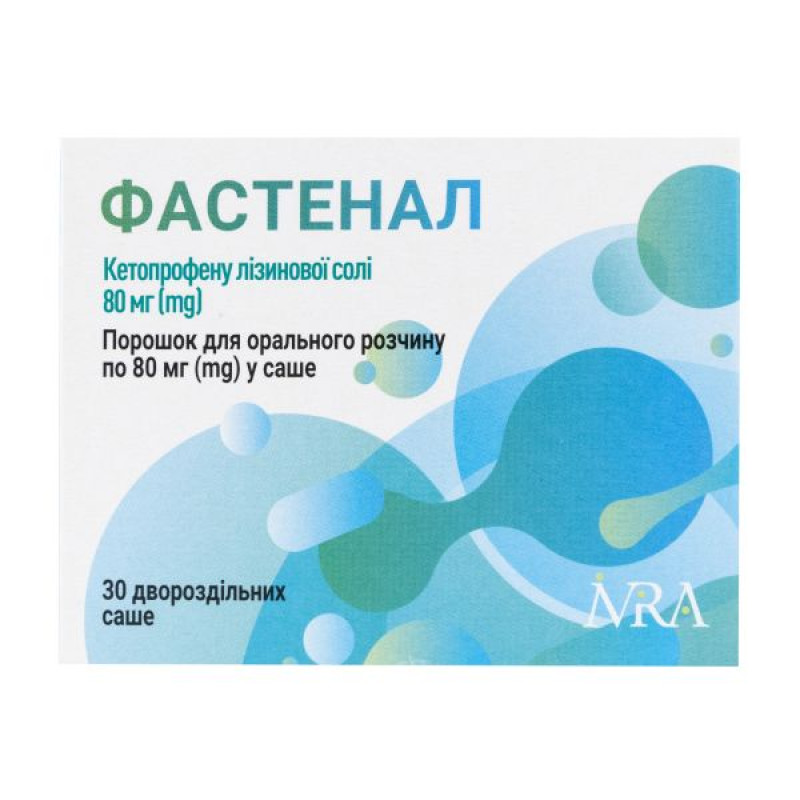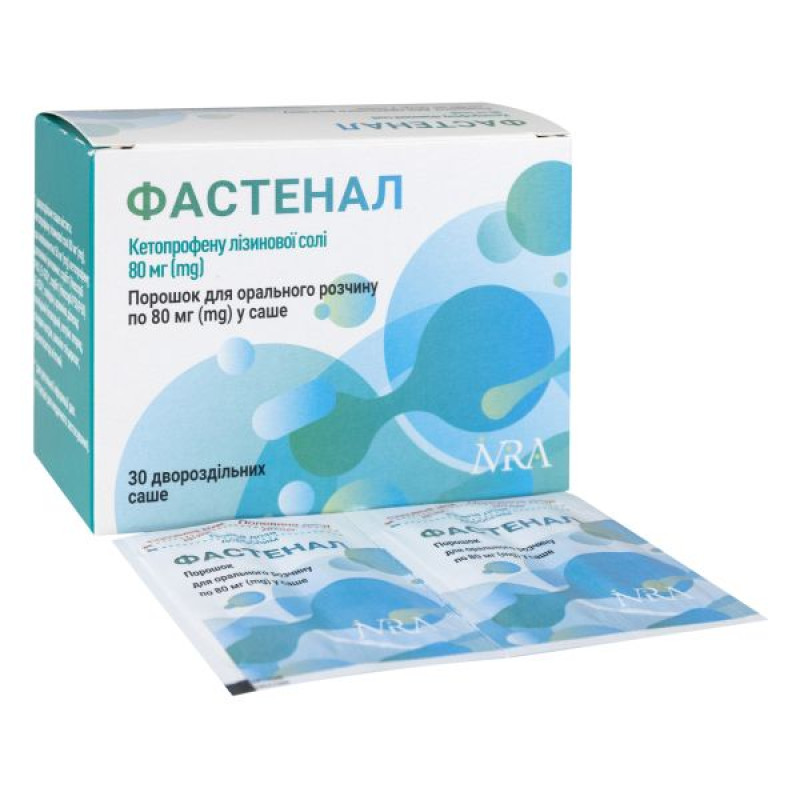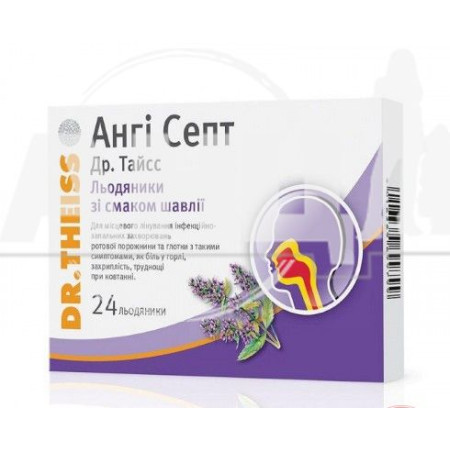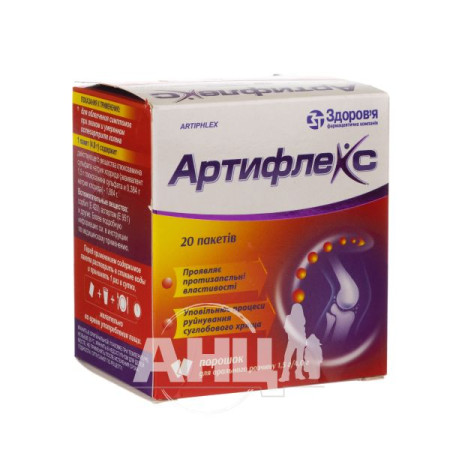Fastenal powder for oral solution 80 mg sachet No. 30
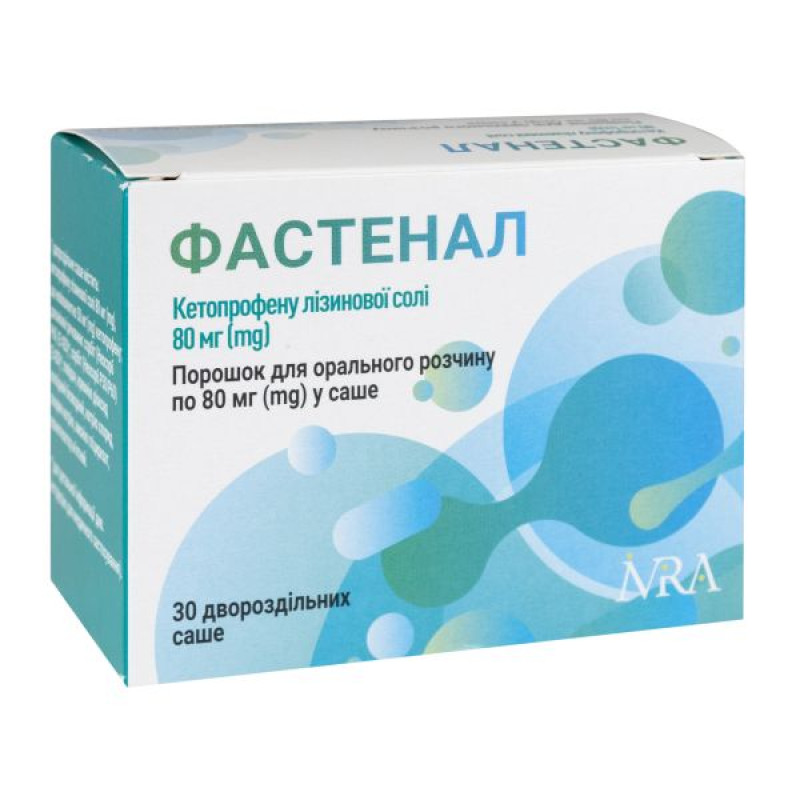
Instructions Fastenal powder for oral solution 80 mg sachet No. 30
Composition
active ingredient: ketoprofen lysine salt;
1 two-part sachet contains 80 mg of ketoprofen lysine salt, which corresponds to 50 mg of ketoprofen;
excipients: sorbitol (Neosorb P60) (E 420), sorbitol (Neosorb P30/P60) (E 420), povidone, colloidal anhydrous silicon dioxide, sodium chloride, sodium saccharin, ammonium glycyrrhizate, mint flavoring.
Dosage form
Powder for oral solution.
Main physicochemical properties: homogeneous powder from white to light yellow.
Pharmacotherapeutic group
Nonsteroidal anti-inflammatory and antirheumatic drugs. Propionic acid derivatives. Ketoprofen.
ATX code M01 AE03.
Pharmacological properties
Pharmacodynamics
Ketoprofen lysine salt is a lysine salt of 2-(3-benzoylphenyl)propionic acid with analgesic, anti-inflammatory and antipyretic effects, belonging to the group of non-steroidal anti-inflammatory drugs (NSAIDs) (M01 AE).
Ketoprofen lysine salt dissolves better than the acid form of ketoprofen.
The mechanism of action of NSAIDs is associated with a decrease in prostaglandin synthesis through inhibition of the enzyme cyclooxygenase. In particular, cyclooxygenase catalyzes the conversion of arachidonic acid to cyclic endoperoxides - PGG2 and PGH2, precursors of prostaglandins PGE1, PGE2, PGF2a and PGD2, as well as prostacyclin PGI2 and thromboxanes (TxA2 and TxB2). In addition, inhibition of prostaglandin synthesis may interfere with other mediators, such as quinines, causing an indirect effect that contributes to the direct action.
Ketoprofen lysine salt has a pronounced analgesic and anti-inflammatory effect, and also exhibits a central analgesic effect.
Ketoprofen lysine salt has an antipyretic effect and does not disrupt normal thermoregulation processes.
Painful inflammatory processes are eliminated or weakened, promoting joint mobility.
Pharmacokinetics
Ketoprofen lysine salt dissolves better than the acid form of ketoprofen.
The oral form allows the active substance to be taken in a water solution, thereby ensuring a rapid increase in its level in the blood plasma and, accordingly, accelerating the achievement of peak concentration.
Clinically, this manifests itself in faster absorption and more intense analgesic and anti-inflammatory effects.
Pharmacokinetic parameters in children do not differ from those in adults.
With repeated administration, the kinetics do not change and the drug does not accumulate.
Ketoprofen is 95-99% bound to blood plasma proteins.
A large amount of ketoprofen was detected in tonsil tissue and synovial fluid when determined by the systemic method.
The drug is rapidly excreted from the body, mainly by the kidneys: 50% of the drug administered systemically is excreted in the urine within 6 hours.
Ketoprofen is well metabolized: 60–80% of the drug administered systemically is metabolized and excreted in the urine.
Indication
Adults: symptomatic treatment of inflammatory processes accompanied by pain in rheumatoid arthritis, ankylosing spondylitis, painful arthrosis, extra-articular rheumatism; post-traumatic inflammation; painful inflammatory diseases in dentistry, otolaryngology, urology and pulmonology.
Children: symptomatic short-term treatment of inflammatory processes accompanied by pain and fever in the following conditions: musculoskeletal diseases, postoperative pain and otitis media.
Contraindication
· Hypersensitivity to the active substance, to other non-steroidal anti-inflammatory drugs (NSAIDs) or to any of the excipients.
History of hypersensitivity reactions such as bronchospasm, asthma attacks, acute rhinitis, nasal polyps, urticaria, nasal polyps, angioedema or other allergic-type reactions to ketoprofen or substances with a similar mechanism of action (e.g. acetylsalicylic acid (ASA) or other NSAIDs). Serious, rarely fatal anaphylactic reactions have been reported in such patients.
Active peptic ulcer/bleeding or history of gastrointestinal bleeding, ulceration or perforation (two or more severe episodes of confirmed ulceration or bleeding) or chronic dyspepsia.
· History of gastrointestinal bleeding or perforation of the gastrointestinal wall associated with the use of NSAIDs, other active bleeding or hemorrhagic diseases.
· Crohn's disease or ulcerative colitis.
· History of bronchial asthma.
Severe heart failure.
Severe liver failure (cirrhosis, severe hepatitis).
Severe renal failure.
· Hemorrhagic diathesis and other blood clotting disorders, as well as hemostasis disorders or patients receiving anticoagulant therapy.
Leukopenia and thrombocytopenia.
Gastritis.
· Conducting intensive diuretic therapy.
· Third trimester of pregnancy.
· Children under 6 years of age.
Interaction with other medicinal products and other types of interactions
· other NSAIDs (including selective cyclooxygenase-2 inhibitors), including salicylates in high doses (≥ 3 g/day): in case of simultaneous use with NSAIDs, the risk of gastrointestinal bleeding or ulcers increases due to mutual enhancement of the effect;
· anticoagulants (e.g. heparin and warfarin): NSAIDs enhance the effect of anticoagulants, which increases the risk of bleeding due to inhibition of platelet function and damage to the gastric and duodenal mucosa. If concomitant use is necessary, it should be carried out under close medical supervision with monitoring of relevant laboratory parameters;
· antiplatelet agents (e.g. ticlopidine and clopidogrel): increased risk of gastrointestinal bleeding due to inhibition of platelet function and damage to the gastric and duodenal mucosa. If concomitant use is necessary, it should be carried out under close medical supervision with monitoring of relevant laboratory parameters;
Lithium: there is a risk of increased blood lithium levels, which may lead to toxicity due to decreased renal lithium excretion. If combination therapy is necessary, careful monitoring of plasma lithium levels is necessary even after discontinuation of NSAID treatment;
Methotrexate, in case of high doses, more than 15 mg/week: increased risk of hematological toxicity, especially when used in high doses (> 15 mg/week), due to displacement of methotrexate from plasma protein binding and reduced renal clearance. At least 12 hours should elapse between stopping or starting treatment with ketoprofen and administering methotrexate;
· hydantoins and sulfonamides: the toxic effect of these substances may be increased.
The simultaneous use of the following medicines requires caution:
· drugs or drug classes that may contribute to the development of hyperkalemia: some drugs or drug classes may contribute to the development of hyperkalemia, such as potassium salts, potassium-sparing diuretics, ACE inhibitors, angiotensin II receptor blockers, nonsteroidal anti-inflammatory drugs (NSAIDs), heparins (low molecular weight or unfractionated), cyclosporine, tacrolimus and trimethoprim. The occurrence of hyperkalemia may also be due to the presence of cofactors. The risk of hyperkalemia increases with concomitant use of the above-mentioned drugs;
· tenofovir: concomitant use of tenofovir disoproxil fumarate and NSAIDs may increase the risk of developing renal failure;
· corticosteroids: there is an increased risk of gastrointestinal ulcers or bleeding;
Diuretics: Dehydrated patients, including those with severe dehydration, and those taking diuretics are at high risk of developing secondary renal failure due to decreased renal blood flow caused by prostaglandin inhibition. Patients should be adequately hydrated and renal function should be monitored after initiating combination therapy. NSAIDs may reduce the effectiveness of diuretics;
ACE inhibitors and angiotensin II antagonists: in some patients with impaired renal function (e.g. dehydrated patients or elderly patients with compromised renal function), the concomitant administration of an ACE inhibitor or angiotensin II antagonist or agents that inhibit cyclooxygenase may lead to further deterioration of renal function, including possible acute renal failure. Therefore, combination therapy should be used with caution, especially in the elderly. Patients should be adequately hydrated and renal function should be monitored after initiation of combination therapy.
· methotrexate used in low doses, less than 15 mg/week: increased hemotoxicity of methotrexate should be taken into account due to a decrease in its renal clearance caused by the action of NSAIDs as such; during the first weeks of combination therapy, blood tests should be performed weekly. If there are changes in renal function, as well as in elderly patients, more frequent monitoring is necessary;
· pentoxifylline: increased risk of bleeding. It is important to increase clinical monitoring and check coagulation time more frequently;
· zidovudine: increased risk of haematological toxicity due to reticulocyte effects, with severe anaemia occurring within a week of starting NSAID treatment. Complete blood count and reticulocyte count should be performed one or two weeks after starting NSAID treatment;
· sulfonylurea: NSAIDs may enhance the hypoglycemic effect of sulfonylureas by displacing their binding to plasma proteins;
Cardiac glycosides: it should be borne in mind that NSAIDs may exacerbate heart failure, reduce glomerular filtration rate and increase cardiac glycoside levels; however, a pharmacotherapeutic interaction between ketoprofen and active glycosides has not been demonstrated.
Possible interactions should be considered when using the following agents:
Mifeprestone: The effectiveness of this method of contraception may theoretically be reduced due to the antiprostaglandin properties of NSAIDs, including aspirin (acetylsalicylic acid). There is some evidence to suggest that co-administration of NSAIDs on the day of a prostaglandin dose does not adversely affect the ability of mifeprestone or prostaglandin to influence cervical ripening or uterine contractility and does not reduce the clinical effectiveness of the medically indicated method of termination of pregnancy.
Intrauterine contraceptive devices (IUDs): the effectiveness of the device may be reduced, thus pregnancy may occur;
· thrombolytics: there is an increased risk of bleeding;
Probenecid: simultaneous administration of probenecid may significantly reduce the clearance of ketoprofen in the blood plasma and, accordingly, the concentration of ketoprofen in the plasma may be increased; this interaction occurs due to the mechanism of inhibition of secretion in the renal tubules and glucuronidation, which requires adjustment of the ketoprofen dose;
· antiplatelet agents (ticlopidine and clopidogrel) and selective serotonin reuptake inhibitors (SSRIs): there is an increased risk of gastrointestinal bleeding;
· cyclosporine, tacrolimus: risk of nephrotoxic additive effects, especially in the elderly. Renal function should be monitored during concomitant therapy;
· Quinolone antibiotics: Animal studies have shown that NSAIDs may increase the risk of convulsions associated with quinolone antibiotics. Patients taking NSAIDs and quinolones concomitantly may be at increased risk of convulsions.
· diphenylhydantoin and sulfonamides: since the degree of binding of ketoprofen to blood proteins is high, a reduction in the dose of diphenylhydantoin or sulfonamides may be necessary if they need to be administered simultaneously with ketoprofen;
· gemeprost: when used simultaneously with NSAIDs, a decrease in the effectiveness of gemeprost is observed;
· avoid drinking alcohol.
Application features
Adverse reactions can be minimized by using the lowest effective dose for the shortest period of time necessary to relieve symptoms.
Concomitant use of ketoprofen with NSAIDs, including selective COX-2 inhibitors, should be avoided.
Gastrointestinal bleeding, ulceration and perforation: Gastrointestinal bleeding, ulceration and perforation, which can be potentially fatal, have been reported with all NSAIDs for any duration, with or without warning symptoms, and with or without a history of serious gastrointestinal disorders.
In the elderly and in patients with a history of ulcer, especially if complicated by bleeding or perforation, the risk of gastrointestinal bleeding, ulceration or perforation is significantly increased with the use of high doses of NSAIDs. In such patients, treatment should be started at the lowest dose that provides a therapeutic effect. In such patients, as well as in patients taking low-dose aspirin or other drugs that may increase the risk of gastrointestinal diseases, the possibility of concomitant use of protective agents (misoprostol or proton pump inhibitors) should be considered. Patients with a history of adverse reactions from the digestive tract, especially the elderly, should report any unusual symptoms felt in the abdominal cavity (special attention should be paid to the risk of gastrointestinal bleeding), especially in the early stages of treatment. Particular caution should be exercised in patients taking concomitant medications that may increase the risk of ulceration or bleeding, including oral corticosteroids, anticoagulants such as warfarin, selective serotonin reuptake inhibitors, or antiplatelet agents such as aspirin.
Elderly patients: Elderly patients have an increased incidence of adverse reactions to NSAIDs, especially gastrointestinal bleeding and perforation, which can be fatal.
As with other non-steroidal anti-inflammatory drugs, in the presence of infection, the anti-inflammatory, analgesic and antipyretic effects of ketoprofen lysine salt may mask the signs and symptoms of progressive infectious diseases, such as fever.
Children: Gastrointestinal bleeding, sometimes severe, and ulceration have been reported in some pediatric patients receiving ketoprofen lysine salt, and such patients should receive the drug under strict medical supervision, who will determine the correct dosage each time.
Gastrointestinal Diseases: Patients with current or past gastrointestinal diseases should be closely monitored for the development of gastrointestinal disorders, especially gastrointestinal bleeding.
If gastrointestinal bleeding or ulceration occurs in patients taking ketoprofen lysine salt, treatment should be discontinued.
According to epidemiological data, the use of ketoprofen lysine salt may be associated with a high risk of severe gastrointestinal adverse reactions, which is typical for other NSAIDs, especially when taken at high doses.
Skin disorders.
Serious skin reactions, some of which were fatal, including exfoliative dermatitis, Stevens-Johnson syndrome and toxic epidermal necrolysis, have been reported very rarely with the use of NSAIDs. The highest risk of such reactions was observed at the beginning of treatment. At the first appearance of skin rashes, mucosal lesions or other signs of hypersensitivity, ketoprofen lysine salt should be discontinued. In order to avoid any manifestations of hypersensitivity or photosensitivity, it is advisable to avoid exposing the skin to the sun while using the medicinal product.
Taking the drug FASTENAL, powder for oral solution 80 mg does not affect the effectiveness of low-calorie diets and does not violate the principles of controlled nutrition; this drug can also be prescribed to patients with diabetes.
FASTENAL, powder for oral solution 80 mg does not contain:
· gluten, therefore this medicine is not contraindicated for people with gluten-sensitive celiac disease;
· aspartame, so it can be prescribed to patients with phenylketonuria.
Precautions.
Liver and kidney dysfunction.
Patients with impaired renal function should be treated with ketoprofen with special caution, given that this drug is excreted mainly by the kidneys. At the beginning of treatment, renal function should be carefully monitored in patients with heart failure, cirrhosis and nephrosis, in patients taking diuretics, in chronic renal failure, especially in the elderly. In such patients, the use of ketoprofen lysine salt may cause a decrease in renal blood flow, which is associated with inhibition of prostaglandins, and lead to renal decompensation. Careful attention and a cautious approach are also required in patients undergoing diuretic therapy, as well as in patients with a high probability of developing hypovolemia, since the risk of nephrotoxicity increases.
As with most NSAIDs, increases in blood urea nitrogen and creatinine levels are possible.
Like other prostaglandin synthesis inhibitors, the drug may adversely affect renal function, which can lead to glomerulonephritis, renal papillary necrosis, nephrosis, and acute renal failure.
In patients with impaired liver function or a history of liver disease, transaminase levels should be monitored regularly, especially during long-term treatment.
Patients taking NSAIDs, including ketoprofen lysine salt, may experience elevations in one or more liver function tests, as well as marked elevations in ALT or AST. If these values are significantly elevated, therapy should be discontinued. Cases of jaundice and hepatitis have also been reported with ketoprofen lysine salt.
During a long course of treatment, liver and kidney function tests, as well as blood tests, should be monitored.
Elderly patients are more likely to have decreased kidney, cardiovascular, or liver function.
Cardiovascular diseases.
Patients with uncontrolled hypertension, congestive heart failure, established ischemic heart disease, peripheral arterial disease and/or cerebrovascular disease should be treated with ketoprofen lysine salt, as with any NSAID, only after careful consideration. Such consideration is necessary at the beginning of long-term treatment in patients with high risk of cardiovascular disease (such as hypertension, hyperlipidemia, diabetes mellitus, smoking).
Patients with a history of hypertension and/or mild to moderate heart failure should be treated with caution and should seek medical advice, as fluid retention and oedema have been reported with NSAID therapy.
Clinical trials and epidemiological data suggest that the use of some NSAIDs (especially at high doses and in long-term use) may be associated with a modest increased risk of arterial thrombotic events (e.g. myocardial infarction and stroke). There are insufficient data to exclude a similar risk for ketoprofen lysine salt.
An increased risk of atrial fibrillation (atrial fibrillation) has been reported with the use of NSAIDs.
Hyperkalemia may develop, especially in patients with diabetes as an underlying disease, as well as with renal insufficiency and/or concomitant therapy with drugs whose active substances contribute to the development of hyperkalemia.
In such a situation, it is necessary to monitor potassium levels.
Use with caution in patients with allergic manifestations or a history of allergies.
The use of ketoprofen, as with all other NSAIDs, in the treatment of patients with bronchial asthma or allergic diathesis may cause an asthmatic crisis. Patients with asthma associated with chronic rhinitis, chronic sinusitis and/or nasal polyposis are at higher risk of developing allergy to acetylsalicylic acid and/or NSAIDs in general than the rest of the population.
Taking this drug may cause asthma attacks or bronchospasm, shock and other allergic reactions, especially in patients who are allergic to acetylsalicylic acid or NSAIDs. Due to the interaction of the drug with arachidonic acid metabolites, asthmatics and predisposed individuals may develop bronchospasm and possibly shock reactions and other allergic reactions.
Visual impairment: Treatment should be discontinued in case of visual impairment, for example, blurred vision.
Ketoprofen lysine salt should be administered with caution to patients suffering from hematopoietic disorders, systemic lupus erythematosus or mixed connective tissue diseases.
Masking of symptoms of underlying infections: FASTENAL, powder for oral solution 80 mg, may mask the symptoms of an infectious disease, which may delay the initiation of appropriate treatment and thereby complicate the course of the disease. This has been observed in bacterial community-acquired pneumonia and bacterial complications of varicella. If FASTENAL, powder for oral solution is used for fever or for pain relief in infections, monitoring for the infectious disease is recommended. In outpatient settings, the patient should seek medical attention if symptoms persist or worsen.
Important information about some excipients.
This medicinal product contains sorbitol, therefore patients with rare hereditary problems of fructose intolerance should not take this medicinal product. If you have been told by your doctor that you have an intolerance to some sugars, contact your doctor before taking this medicinal product.
Use during pregnancy or breastfeeding
The use of ketoprofen should be avoided in the first and second trimesters of pregnancy.
Inhibition of prostaglandin synthesis may adversely affect pregnancy and/or embryo/fetal development, therefore ketoprofen lysine salt should not be taken during pregnancy.
Epidemiological data suggest an increased risk of miscarriage and of cardiac malformations and hiatal hernia following the use of prostaglandin synthesis inhibitors in early pregnancy. The absolute risk of cardiac malformations has increased from less than 1% to almost 1.5%. This risk is thought to increase with increasing dose and duration of treatment. In animal studies, the use of a prostaglandin synthesis inhibitor has been shown to result in increased pre- and post-implantation losses and embryo/fetal death. In addition, an increased incidence of various malformations, including cardiovascular, has been reported in animals treated with a prostaglandin synthesis inhibitor during organogenesis.
During the first and second trimesters of pregnancy, ketoprofen lysine salt should be taken only if clearly necessary.
When using ketoprofen lysine salt in women planning pregnancy, or during the first or second trimester of pregnancy, the dose should be as low as possible and the duration of treatment as short as possible.
During the third trimester of pregnancy, all prostaglandin synthesis inhibitors may affect the fetus, causing:
Cardiopulmonary toxicity (with premature closure of the ductus arteriosus and pulmonary hypertension);
· renal dysfunction, which may progress to renal failure in oligohydramnios.
At the end of pregnancy, prostaglandin synthesis inhibitors in the mother and newborn may lead to:
· possible prolongation of bleeding time and antiplatelet effect even at very low doses;
· suppression of uterine contractions, which can lead to delayed or prolonged labor.
Use of the drug before delivery may cause changes in the hemodynamics of the small circle of blood circulation of the unborn child with serious consequences for the respiratory system.
Therefore, the drug is contraindicated during the third trimester of pregnancy.
Breastfeeding.
There is no information on the penetration of ketoprofen into breast milk. Ketoprofen is not recommended during breastfeeding.
Fertility.
The use of ketoprofen lysine salt, like any other drug that inhibits prostaglandin and cyclooxygenase synthesis, may impair female fertility and is therefore not recommended for use in women attempting to conceive.
For women who are having difficulty conceiving or are undergoing infertility investigations, ketoprofen lysine salt should be discontinued.
Ability to influence reaction speed when driving vehicles or other mechanisms
Patients should be aware of the possible occurrence of drowsiness, dizziness, or seizures and should avoid driving or performing activities requiring special alertness if these symptoms occur.
Method of administration and doses
The maximum daily dose is 200 mg ketoprofen, corresponding to 320 mg ketoprofen lysine salt. Before starting treatment with a daily dose of 200 mg ketoprofen, the potential risk and expected benefit should be carefully assessed; the use of higher doses is not recommended.
Children 6–14 years old: dissolve the contents of ½ a two-part sachet, 40 mg (half a dose), in 100 ml of water, mix and take orally 3 times a day with meals.
Use in children under 6 years of age is contraindicated.
Elderly: The dosage should be determined in detail by the physician, who should evaluate a possible dose reduction as indicated below.
Patients with hepatic insufficiency: it is recommended to start treatment with the minimum daily dose.
Patients with mild or moderate renal insufficiency: it is recommended to reduce the initial dose and carry out maintenance therapy using the lowest effective dose. Individual dosage adjustment is possible only after establishing good tolerability of the drug. Monitor diuresis and renal function.
The drug should not be taken by patients with severe liver and kidney dysfunction.
The lowest effective dose should be used for the shortest time necessary to relieve symptoms.
Instructions for use of the sachet: to obtain a half dose (40 mg), open the sachet along the line marked “half dose”. To obtain a full dose (80 mg), open the sachet along the line marked “full dose”. Dissolve the contents of one sachet or half a sachet in 100 ml of water and mix.
Children.
The drug should not be used in children under 6 years of age.
Overdose
Cases of overdose with doses exceeding 2.5 g of ketoprofen lysine salt have been reported. In most cases, the symptoms observed were of a benign nature and were limited to lethargy, drowsiness, nausea, vomiting and epigastric pain. Symptoms of overdose may also include: central nervous system disorders such as headache, dizziness, confusion and loss of consciousness, as well as pain, nausea and vomiting. Hypotension, respiratory depression and cyanosis may also occur.
There is no specific antidote for ketoprofen lysine salt overdose. In case of suspected severe overdose, gastric lavage and supportive or symptomatic treatment to compensate for fluid deficit are recommended, and renal function should be monitored and acidosis corrected if present.
In case of renal failure, the drug can be removed from the systemic circulation by hemodialysis.
Adverse reactions
Experience with oral ketoprofen lysine salt preparations suggests that adverse reactions are very rare.
Based on patient assessment, based on the number of packages consumed and taking into account the number of voluntary reports, less than one patient in 100,000 experienced adverse reactions. In most cases, the symptoms resolved and did not recur after discontinuation of use, and in some cases, after specific treatment.
Information on the adverse reactions listed below has been collected from the use of ketoprofen lysine salt in adults.
Adverse reactions are classified according to frequency of occurrence: very common (≥ 1/10), common (from
≥ 1/100 to based on available data).
Infections and infestations: frequency unknown - aseptic meningitis, lymphangitis.
Blood and lymphatic system disorders: Rare: anemia due to bleeding; Frequency unknown: thrombocytopenia, agranulocytosis, bone marrow aplasia, hemolytic anemia, leukocytosis, lymphangitis, purpura, thrombocytopenic purpura, and leukopenia.
Immune system disorders: frequency unknown - anaphylactic reactions (including anaphylactic shock), hypersensitivity.
Metabolism and digestion disorders: frequency unknown - hyperkalemia, hyponatremia.
Psychiatric disorders: frequency unknown - depression, confusion, mood swings, agitation, insomnia; a single case of anxiety, visual hallucinations, increased excitability and behavioral changes has been described in a child who took a dose twice the recommended dose; the symptoms disappeared after 1–2 days.
Nervous system: infrequently - headache, dizziness, drowsiness, vertigo; rarely - paresthesia; very rarely - dyskinesia, chills, fainting, dizziness; frequency unknown - convulsions, ageusia, dysgeusia; one case of tremor and hyperkinesia was reported in an elderly patient who was simultaneously receiving a quinolone antibiotic.
On the part of the organs of vision: rarely - blurred vision; frequency unknown - periorbital edema.
From the side of the organs of hearing and vestibular apparatus: rarely - tinnitus.
Cardiac disorders: frequency unknown - heart failure, atrial fibrillation, palpitations and tachycardia.
Respiratory, thoracic and mediastinal disorders: rarely - asthma; very rarely - laryngeal oedema; frequency unknown - bronchospasm (especially in patients with known hypersensitivity to acetylsalicylic acid and other NSAIDs), rhinitis, dyspnoea, laryngospasm. One case of acute respiratory failure with fatal outcome was reported in an asthmatic and in a patient with hypersensitivity to aspirin. Most of the adverse reactions were serious in patients with an allergic reaction, suffering from asthma or known hypersensitivity to NSAIDs.
Gastrointestinal disorders: the most frequently observed adverse drug reactions are gastrointestinal reactions; gastric ulcer, perforation and gastrointestinal bleeding may occur, sometimes with fatal outcome, especially in elderly patients. Common - nausea, vomiting, dyspepsia, abdominal pain; uncommon - constipation, diarrhea, flatulence, gastritis, abdominal discomfort; rare - ulcerative stomatitis, gastric ulcer, colitis; frequency unknown - exacerbation of colitis and Crohn's disease, gastrointestinal bleeding and perforation (sometimes with fatal outcome, especially in elderly patients), gastric ulcer, duodenal ulcer, heartburn, swelling of the oral mucosa, pancreatitis, melena, hematomesia, hyperchlorhydria, stomach pain, erosive gastritis, swelling of the tongue.
From the liver and biliary tract: rarely - hepatitis, increased transaminase levels, increased serum bilirubin levels due to liver dysfunction, jaundice.
Skin and subcutaneous tissue disorders: infrequently - itching, rash; unknown - photosensitivity, alopecia, urticaria, angioedema, bullous dermatitis, including Stevens-Johnson syndrome, Lyell's syndrome and toxic epidermal necrolysis, erythema, exanthema, contact eczema, maculopapular rash, purpura, acute generalized exanthematous pustulosis, dermatitis.
Renal and urinary disorders: very rarely - hematuria; frequency unknown - acute renal failure, tubulointerstitial nephritis, nephritis or renal syndrome, glomerular nephritis, water/sodium retention with possible development of edema, acute tubular necrosis, renal papillary necrosis, oliguria, signs of renal dysfunction, dysuria.
General disorders and administration site conditions: uncommon - edema, fatigue, peripheral edema, chills; very rare - asthenia, facial edema; unknown - allergic and anaphylactic reactions, anaphylactic shock, oral edema. Isolated cases of fainting have been reported.
Laboratory abnormalities: rarely - weight gain.
Expiration date
3 years.
Storage conditions
This medicinal product does not require any special storage conditions. Keep out of the reach of children!
Packaging
2 g of the medicinal product, corresponding to 80 mg of ketoprofen lysine salt, in a two-part paper/aluminum/polyethylene sachet. 30 two-part sachets together with instructions for medical use in a cardboard box.
Vacation category
According to the recipe.
Manufacturer/applicant. SPECIAL PRODUCTS LINE S.P.A., Italy/UAB "MRA", Republic of Lithuania.
Location of the manufacturer and its business address/location of the applicant.
Via Fratta Rotonda Vado Largo, 1, Anagni (FR), 03012, Italy/Vul. Totoriu 20-9, LT-01121, Vilnius, Republic of Lithuania.
There are no reviews for this product.
There are no reviews for this product, be the first to leave your review.
No questions about this product, be the first and ask your question.







